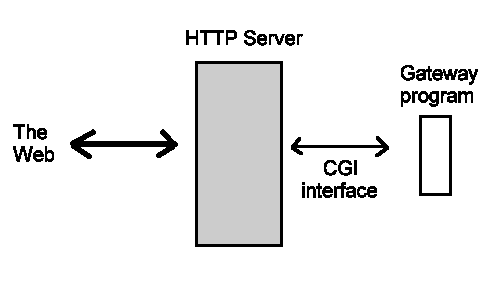
An illustration of the way in which gateway programs communicate with Web (HTTP) servers and with the Web
| ToC ~ Up ~ Prev ~ Next ~ Index |
Introduction to HTML Last Update: 5 January 1998 |
This document is a brief introduction to the Common Gateway Interface. For more detailed information see the extensive NCSA documentation, found here.
The CGI (Common Gateway Interface) is the standard by which external programs (often called gateways, or gateway programs) can interface with a HTTP (Web) server. Thus CGI programs act as gateways between the HTTP server and databases, or between the server and local programs or document generators. An illustration of how this all works is found in the following Figure:

An illustration
of the way in which gateway programs communicate with Web (HTTP) servers
and with the Web
For example, a CGI program can be designed to handle an information request to a database, take the results and assemble an HTML document from it, and return this document to your browser. Consequently CGI gateway programs are used to process information obtained via ISINDEX, FORMS or ISMAP (active image map) requests to an HTTP server.
With NCSA HTTP servers the CGI programs and scripts are placed
in a special directory often named cgi-bin -- there
may in fact be many of these directories, with names such as
cgi-bin, cgi-stuff, htbin,
and so on. The cgi-bin directory
is often referenced by URLs like http://stuff.cc.dd/cgi-bin/.
Therefore whenever you see this type of url you can expect
that a gateway program is being
referenced.
The NCSA documentation described in detail how to write these scripts, and mentions important ** security issues **. Please read the NCSA CGI documentation. For an overview of the CGI mechanisms and the HTTP protocol see our CGI Overview documentation.
| ToC ~ Up ~ Prev ~ Next ~ Index |
Introduction to HTML © 1994-1998 by Ian Graham Last Update: 5 January 1998 |